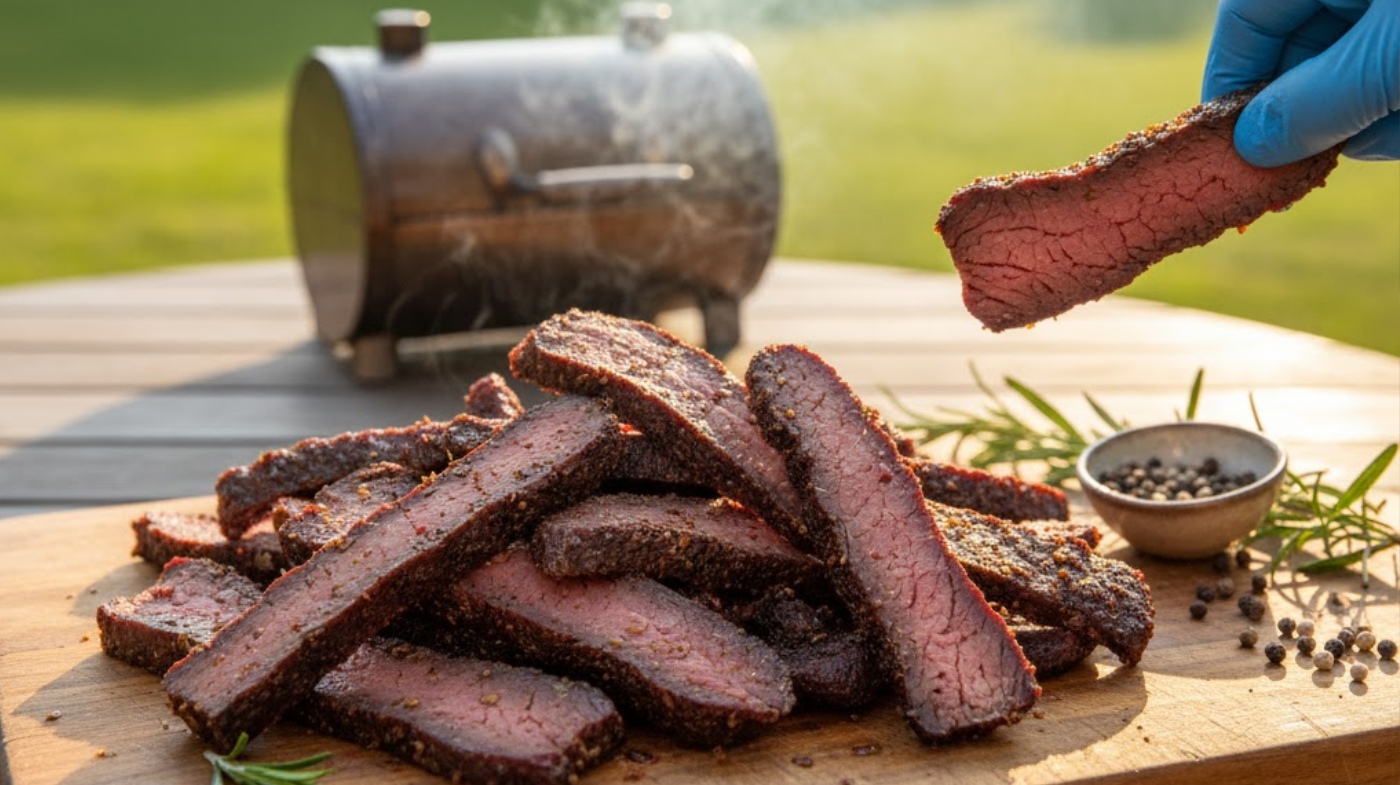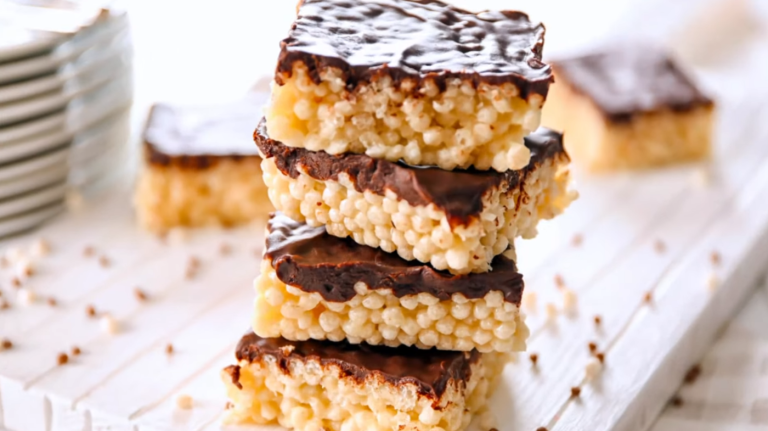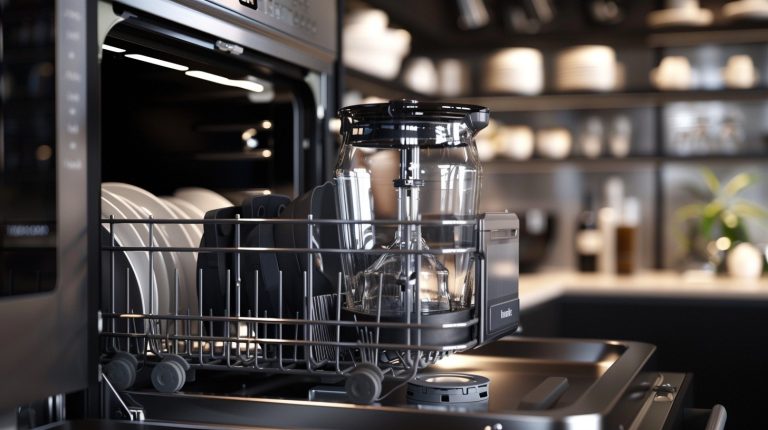What Is Kippered Beef? The Smoky Snack You’ll Love
Kippered beef is tender, smoky strips of beef cured with salt and spices, then cold smoked at low temperatures to keep moisture and flavor.
Unlike firm, dry jerky, kippered beef is thicker and juicier, with a rich, mild smoky taste and a texture close to a small steak.
The process involves careful curing, drying, and smoking to balance tenderness and flavor. Keep exploring, and you’ll uncover the detailed steps and traditions behind this flavorful cured meat.
Key Takeaways
- Kippered beef is cured, seasoned, and cold-smoked thick strips of beef producing a tender, smoky, and moist meat product.
- Originating from early settlers, it uses heavy salting and wood fire smoking inspired by kippered herring preservation methods.
- The preparation involves dry curing with spices, vacuum sealing, cold smoking at low temperatures, and refrigeration before slicing.
- It has a softer texture and richer flavor compared to beef jerky, with mild smoky notes and natural beef taste.
- Proper storage with vacuum sealing and humidity control maintains its tenderness, flavor, and shelf life.
Definition and Historical Background of Kippered Beef
What exactly is kippered beef, and how did it come to be a preserved meat staple?
Kippered beef is a cured meat made by salting, seasoning, and smoking thick strips of beef, resulting in a tender, smoky product that retains more moisture than traditional jerky. This preservation method parallels other traditional techniques such as wrapping in heavy-duty foil to protect against moisture loss and contamination.
Its origins trace back to frontiersmen and early settlers who needed durable, portable food. Without refrigeration, they relied on heavy salting to prevent spoilage and smoked the beef over wood fires to add flavor and extend shelf life. Salt was the primary preservation method, used to cure thin slices of beef.
This practical method, inspired by kippered herring techniques, became essential for enduring harsh winters. Passed down through generations, especially in rural communities, kippered beef grew into a regional specialty valued for its preservation quality and taste, sustaining people in challenging environments.
Key Differences Between Kippered Beef and Beef Jerky
When you compare kippered beef to beef jerky, there are some pretty noticeable differences. For starters, kippered beef is thicker and juicier, while jerky tends to be thin and dry. It’s interesting how their preparation methods really set them apart, too. Proper food preservation techniques play a crucial role in how these meats are prepared and stored.
Kippered beef is cold-smoked, which helps it retain more moisture, whereas jerky goes through a dehydration process to ensure it has a longer shelf life. Because of this, kippered beef usually needs refrigeration due to moisture.
And let’s talk about flavor! Kippered beef has this rich, smoky taste that can be really satisfying. On the other hand, jerky delivers that concentrated, chewy snack experience that many people love.
Texture and Thickness
Although both kippered beef and beef jerky undergo drying processes, their textures and thicknesses differ considerably, affecting how you experience each snack.
Kippered beef is cut much thicker, often resembling a small steak, while jerky is sliced thin, usually a quarter-inch or less. This thickness allows kippered beef to retain more internal moisture, giving it a softer, juicier, and more tender texture. Proper drying techniques, such as maintaining dehydration temperature, are crucial to achieving this texture.
In contrast, jerky’s thin slices dry out completely, resulting in a firm, tough, and chewy bite. The moisture content in kippered beef remains higher, so it feels less dry and offers a mouthfeel closer to cured meat rather than a leathery snack. Because of this, kippered beef typically requires refrigeration and vacuum packaging to maintain its quality and safety.
Preparation and Curing
Since curing is essential to developing the unique flavor and texture of kippered beef, understanding its preparation sets it apart from beef jerky. You’ll notice kippered beef undergoes a thorough dry curing process, where salt, curing salts with nitrites, sugar, and spices are rubbed evenly onto thawed, uniform meat pieces.
This ensures deep cure absorption, often aided by vacuum sealing. The process of osmosis and diffusion works slowly during curing to draw moisture out and distribute salt evenly within the meat, contributing to both preservation and flavor development through slow transformation.
Then, the meat is carefully smoked and dried at lower temperatures with controlled humidity to develop texture and preserve it safely. Key preparation steps include:
- Applying a finely ground dry cure evenly on all surfaces.
- Vacuum sealing to eliminate air and enhance cure penetration.
- Slow cold smoking at 110–160°F without added humidity.
- Refrigerating overnight to stabilize before slicing or storage.
Flavor Profiles
You’ll find that flavor profiles set kippered beef and beef jerky distinctly apart, shaping your tasting experience from the first bite.
Kippered beef offers a milder, savory taste with natural beef notes and moderate saltiness. It is often enhanced by simple spices like garlic and pepper. Its shorter smoking process means the smoky flavor is subtle, and sweetness is minimal, usually from light brown sugar. Proper slicing against the grain can further enhance its tender texture. Unlike traditional kippered beef, some products may be chopped and formed rather than whole muscle, affecting texture and flavor authenticity chopped and formed beef.
In contrast, beef jerky hits you with bold, concentrated flavors, often sweet, salty, and spicy. This is thanks to heavy seasoning blends including chili, paprika, and sugar. Jerky’s intense saltiness and dryness contrast with kippered beef’s tender, juicier texture and balanced seasoning.
When you savor kippered beef, expect a more natural, less processed flavor experience that highlights the meat itself. Using proper knife sharpening techniques ensures clean cuts that preserve the meat’s flavor and texture.
Step-by-Step Preparation Techniques
When preparing kippered beef, selecting the right cut and slicing it properly sets the foundation for both flavor and texture.
Start by choosing lean cuts like flank steak or chuck roast and trim all visible fat to prevent spoilage. A marinade that balances spices and liquids enhances both tenderness and flavor. Considering the material durability of your storage container can help maintain freshness.
Chill the meat for 30 to 60 minutes to firm up before slicing into ¾ to 1-inch strips.
Decide whether to cut with or against the grain based on your texture preference.
- Trim fat thoroughly to improve shelf life and texture.
- Slice chilled meat thicker than jerky for moisture retention.
- Marinate strips using a balanced seasoning mix for deep flavor.
- Smoke at controlled low temperatures, monitoring internal heat to maintain tenderness.
The Role of Curing and Brining in Flavor Development
Although curing and brining might seem like simple preservation steps, they play a crucial role in shaping the flavor profile of kippered beef.
Salt and curing agents inhibit microbial growth and trigger savory, umami notes. Sugars in brines balance saltiness and enhance caramelization during drying. Proper curing time of at least 12 hours and preferably several days ensures thorough flavor penetration and optimal texture. These processes are similar to the precise heating methods used in cheese melters to enhance flavor and texture.
Spices infuse aromatic complexity, and curing time deepens flavor by allowing better penetration and protein interaction.
| Aspect | Flavor Impact |
|---|---|
| Salt & Nitrites | Preserve, add savory, pink cured color |
| Sugar in Brine | Balances salt, promotes Maillard reactions |
| Spices & Herbs | Impart aromatic, complex flavor compounds |
Detailed Smoking Process for Optimal Texture
Building on the foundation of curing and brining, the smoking process shapes the final texture and intensifies the flavor of kippered beef. To optimize texture, you’ll want to carefully control temperature and airflow:
- Start with a drying phase at 110°F for 90 minutes, keeping humidity low to form a pellicle that absorbs smoke.
- Smoke at 140°F for 30 minutes with low humidity to develop flavor without cooking the meat.
- Increase to 145°F for 15 minutes to further dry and firm the surface, enhancing texture.
- Optionally, extend smoking at 110°F up to 4 hours or adjust between 160°F and 140°F for balanced smoke penetration and texture. Consistent use of a smoker capable of maintaining 225°F ensures stable temperature control during longer smoking phases.
Use hardwoods like hickory for steady, thin smoke. Arrange strips with good airflow for even smoking. Proper airflow is essential to prevent carbon stains that can affect the appearance and quality of the meat.
Exploring the Texture and Flavor Profiles
Since kippered beef retains a higher moisture content than traditional jerky, you’ll notice a juicier, softer texture that enhances its eating experience. This style of jerky is often made from lean, fresh meat with no gristle, contributing to its tender and flavorful bite.
Thicker cuts and slicing against the grain ensure tenderness while preserving a pleasantly chewy bite. Unlike dry jerky, kippered beef avoids toughness by maintaining moisture around twice that of jerky, requiring refrigeration to keep its juiciness intact.
Flavor-wise, it delivers robust, beef-forward notes enriched by smoky aromas and well-balanced seasonings like salt, brown sugar, vinegar, and spices. The moist texture lets these flavors linger, offering a more complex palate than drier snacks.
The slight firmness from smoking contrasts with the tender interior, creating a satisfying mouthfeel that’s rich but not greasy, making kippered beef a uniquely flavorful and textured meat product. Additionally, it is commonly vacuum sealed to maintain freshness and quality during storage and shipping. Proper storage and humidity control are crucial for preserving the product’s texture and flavor over time.
Commercial Production vs. Homemade Variations
When you think about kippered beef, it’s interesting to compare how it’s made commercially versus at home. In commercial production, they use precise temperature controls and have strict curing standards. This really helps ensure that the products are safe and consistent. Commercial facilities often use electric smokers to maintain consistent heat and smoke levels during the process.
On the other hand, when you’re making kippered beef at home, things are a bit different. You usually rely on simpler cures and have more flexibility with smoking times. This can definitely lead to some variation in texture and flavor, which is part of the fun of homemade cooking! Homemade methods typically involve curing the beef with a combination of tenderizers, sugar, and pepper before smoking, which contributes to its distinctive taste and texture curing process.
Commercial Processing Methods
Although both commercial and homemade methods aim to produce flavorful, shelf-stable kippered beef, the commercial process relies on precise control and specialized equipment to guarantee consistent quality and safety at scale.
You’ll notice commercial producers use uniform slicing, vacuum tumblers, and controlled smoking to ensure every batch meets strict standards.
Here’s what defines commercial processing:
- Industrial slicers cut beef uniformly for even drying and texture.
- Vacuum tumblers infuse marinades deeply and evenly.
- Controlled smoke schedules with specific temperatures create consistent flavor and drying.
- Packaging with oxygen absorbers extends shelf life to six months or more.
Additionally, commercial kippered beef often features all natural-wood-smoked preparation to enhance flavor while maintaining its natural qualities.
This systematic approach, guided by rigorous testing and HACCP principles, ensures you get a safe, high-quality kippered beef product every time. Proper storage practices also play a crucial role in maintaining the product’s freshness and preventing spoilage.
Homemade Preparation Techniques
Commercial kippered beef production relies on precise machinery and controlled environments to guarantee consistency.
But making it at home offers flexibility and personal touches that machines can’t replicate.
When preparing at home, you start by selecting lean cuts like eye of round or sirloin, trimming fat for better texture and shelf life.
You can slice the beef about ½ inch thick, then cure it using a brine of salt, sugar, curing salt, and spices.
Vacuum tumbling or soaking for 24 to 48 hours ensures deep flavor.
For drying, you’ll control temperature carefully, starting low heat without smoke, then smoking at moderate temps to develop flavor.
Maintaining a steady smoking temperature around 170-180°F helps infuse rich flavor while preserving tenderness.
Unlike commercial setups, your home smoker allows you to adjust drying and smoking times, tailoring tenderness and smokiness to your taste.
Frequently Asked Questions
How Should Kippered Beef Be Stored for Maximum Shelf Life?
To maximize kippered beef’s shelf life, store unopened packages in a cool, dry place below 70°F.
Keep it away from direct sunlight and humidity.
Maintain its original airtight or vacuum-sealed packaging to prevent moisture and contamination.
After opening, transfer it to an airtight container, refrigerate, and consume within a week.
For longer storage, you can freeze it, but tightly wrap it to avoid freezer burn and texture changes.
Can Kippered Beef Be Safely Frozen and Reheated?
Yes, you can safely freeze and reheat kippered beef if you handle it properly.
Cool it completely, slice into portions, and use airtight or vacuum-sealed bags to prevent freezer burn.
Freeze at 0°F (-18°C) or below, and thaw it in the fridge overnight.
When reheating, use low heat until it reaches 140°F (60°C) to keep it tender and safe.
Avoid repeated thawing and reheating to maintain quality and safety.
What Are the Best Side Dishes to Serve With Kippered Beef?
To elevate your kippered beef experience, you can’t go wrong with classic mashed potatoes or a tangy cucumber salad that brightens the plate.
Roasted root vegetables or smoky baked beans add comforting warmth, while a crisp wedge salad offers an invigorating contrast.
Don’t forget cornbread for a slightly sweet touch. These sides balance kippered beef’s rich flavor, creating a well-rounded and satisfying meal you’ll look forward to every time.
Is Kippered Beef Suitable for Low-Sodium Diets?
Kippered beef isn’t ideal for low-sodium diets since it packs 250 to 570 mg of sodium per ounce, often exceeding 20% of your daily limit.
If you’re managing hypertension or kidney issues, you should limit or avoid it.
However, if you do enjoy it, pair it with low-sodium sides and stay hydrated.
Always check labels for lower-sodium options and consult your healthcare provider for personalized guidance.
Are There Vegetarian or Plant-Based Alternatives to Kippered Beef?
You can definitely find plant-based alternatives to kippered beef.
Imagine marinating shredded jackfruit in smoky, spiced brine, then cold smoking it to mimic that salty, umami-rich flavor.
Jackfruit’s fibrous texture absorbs those flavors well, making it a fantastic vegan substitute.
Similarly, you can use seitan or mushrooms prepared this way.
These options give you that cured, smoky taste without animal products, perfect for sandwiches or snacks.
Bring the Flavor Home: Make Your Own Kippered Beef
Now that you know what kippered beef is and how it differs from beef jerky, you can appreciate the careful curing, brining, and smoking that shape its unique flavor and texture.
Making it at home or buying it commercially is like revealing a time-honored tradition preserved in every bite. Just as a well-tuned instrument produces rich, resonant notes, kippered beef offers a deep, savory experience that’s both satisfying and unforgettable.







